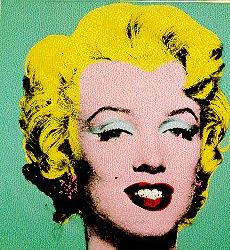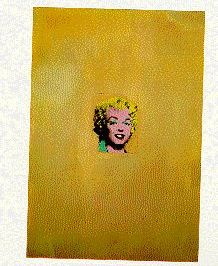
Turquoise Marilyn, 1962

Warhol was fascinated with Hollywood superstars. Turquoise Marilyn is one of about thirty different silkscreen editions of this famous face created between 1962 and 1964. All the pictures in these series are based a promotional photograph Warhol purchased from the 1953 film Niagara.
Warhol painted Marilyn's public image, glamorous, seductive, and garish. It's the only image most of us are familiar with, really. Where Marilyn's public mask ended and the real person began, however, remains a mystery—just as it has with Warhol himself.
The artist's Marilyns, like his other portraits, communicate a machine aesthetic, flat and deadpan. Do they express Warhol's notion that "everybody should be a machine"?
Here's a sampling of Marilyn criticism:
At his strongest—and I take this to be in his Marilyn Monroe paintings—Warhol has a painterly competence, a sure instinct for vulgarity (as in his choice of colors) and a feeling for what is truly human and pathetic in one of the exemplary myths of our time that I for one find moving; but I am not at all sure that even the best of Warhol's work can much outlast the journalism on which it is forced to depend.
Some consideration should be given to the portraits Warhol has
done . In the long run, it may be these works which emerge at his best, because in
the portraits, especially in those of Marilyn Monroe and the Elizabeth Taylor, the artist
has carried his theme of the machine product to its logical, if disquieting,
conclusionp—eople as machine products, commercial property.
—Paul Bergin, Andy Warhol: The Artist as Machine," 1967
 |
Gold Marilyn, 1962 |
Rather than heightening her facial features, her makeup elements
actually conceal them, becoming a barrier between us and her. The veneer of color,
not the person beneath it, is the subject here. Warhol advised us to "look at
the surface of my paintings. . . There's nothing behind it." . .
.Warhol was not celebrating Marilyn's beauty but the technicolor myth of it.
—B. Collins, "The Metaphysical Nose
Job: The Remaking of Warhola, 1960-68," 1988
The colored Marilyn Monroes are like theorems, or mourning
picturess—cenes with urns and weeping willows, where the stenciled application of one
colored section next to another is so stiffly machanical and awkward that it conveys more
of a sense of the hand that make the work than an average watercolor does.
—S. Schwartz, "Andy Warhol the Painter," 1989
The images of Marilyn remain vital precisely
because they have bridged the gap separating the participatory present form the past and
are located in the memories they have themselves created. The potency of Warhol's
icons lies very much in their ability to become a part of the mythology of their subject
matter.
—Steve Jones, "Andy Warhol's Allegorical Icons," 1997
Return to Warhol's Critics